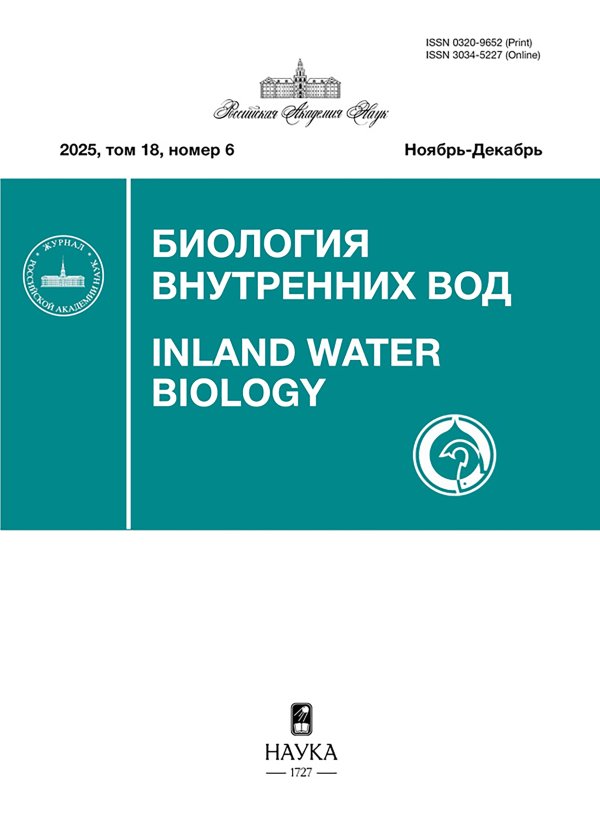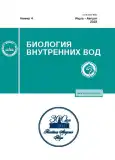Impacts of the High-Pressure Bratskoye Hydroelectric Power Station on the Zooplankton of the Bratskoye Reservoir
- Authors: Gerasimov Y.V.1, Poddubnaya N.Y.2, Vakhnenko A.F.3, Semenova A.S.1,4, Zhdanova S.M.1, Tsvetkov A.I.1, Pavlov D.D.1, Bolotov S.E.1, Borisenko E.S.1,5
-
Affiliations:
- Papanin Institute for Biology of Inland Waters, Russian Academy of Sciences
- Cherepovets State University
- Independent researcher
- Russian Federal Research Institute of Fisheries and Oceanography, Atlantic Branch
- Severtsov Institute of Ecology and Evolution, Russian Academy of Sciences
- Issue: No 4 (2023)
- Pages: 473-490
- Section: ЗООПЛАНКТОН, ЗООБЕНТОС, ЗООПЕРИФИТОН
- URL: https://journals.rcsi.science/0320-9652/article/view/134908
- DOI: https://doi.org/10.31857/S0320965223040083
- EDN: https://elibrary.ru/RVSCQV
- ID: 134908
Cite item
Full Text
Abstract
During the growing season of 2022, the studies were carried out in the water area of the Bratsk Reservoir (the Angara River) and in the near-dam site of the Bratsk high-level hydroelectric power station. The ecological effects of the hydroelectric dam on the zooplankton in the regulated section of the river were studied and the impact of the zooplankton downstream drift on the feeding conditions of the fish in the Bratsk Reservoir was assessed. It is established that the water column stratification is a significant factor in the ecological differentiation of plankton communities in the upper reaches of the hydroelectric power station. Unlike the warmed-up layer of the epilimnion, a specific, poor in species, low-abundant and low-productive plankton develops in the cold-water hypolimnion, which enters the dam intakes. A rigorous analysis does not reveal a transformation of the community composition, a statistically significant decrease in abundance and productivity, increased mortality of invertebrates during their passage through the dam, deterioration of the water ecological quality in the lower reaches of the hydroelectric power station. Both live and dead zooplankton drifting downstream from the reservoir makes up a significant proportion of the diet of fish, which during the feeding period come as close as possible to the hydroelectric power station and form aggregations exceeding those in the water area of the Bratsk Reservoir in density. The data obtained testify to the effective adaptation of lake-river planktocenosis to the specific natural and technogenic mode of operation of a large hydraulic structure. The local impact of the Bratsk hydroelectric power station has no ecologically significant negative effect on the plankton of the Bratsk Reservoir and the Angara River ecosystems and has a positive effect on the fish population in the lower reaches through the enrichment of its forage base.
Keywords
About the authors
Yu. V. Gerasimov
Papanin Institute for Biology of Inland Waters, Russian Academy of Sciences
Author for correspondence.
Email: gu@ibiw.ru
Russia, Nekouzskii raion, Yaroslavl oblast,
Borok
N. Ya. Poddubnaya
Cherepovets State University
Email: gu@ibiw.ru
Russia, Cherepovets
A. F. Vakhnenko
Independent researcher
Email: gu@ibiw.ru
Russia, Bratsk
A. S. Semenova
Papanin Institute for Biology of Inland Waters, Russian Academy of Sciences; Russian Federal Research Institute of Fisheries and Oceanography, Atlantic Branch
Email: gu@ibiw.ru
Russia, Nekouzskii raion, Yaroslavl oblast,
Borok; Russia, Kaliningrad
S. M. Zhdanova
Papanin Institute for Biology of Inland Waters, Russian Academy of Sciences
Email: gu@ibiw.ru
Russia, Nekouzskii raion, Yaroslavl oblast,
Borok
A. I. Tsvetkov
Papanin Institute for Biology of Inland Waters, Russian Academy of Sciences
Email: gu@ibiw.ru
Russia, Nekouzskii raion, Yaroslavl oblast,
Borok
D. D. Pavlov
Papanin Institute for Biology of Inland Waters, Russian Academy of Sciences
Email: gu@ibiw.ru
Russia, Nekouzskii raion, Yaroslavl oblast,
Borok
S. E. Bolotov
Papanin Institute for Biology of Inland Waters, Russian Academy of Sciences
Email: gu@ibiw.ru
Russia, Nekouzskii raion, Yaroslavl oblast,
Borok
E. S. Borisenko
Papanin Institute for Biology of Inland Waters, Russian Academy of Sciences; Severtsov Institute of Ecology and Evolution, Russian Academy of Sciences
Email: gu@ibiw.ru
Russia, Nekouzskii raion, Yaroslavl oblast,
Borok; Russia, Moscow
References
- Ахметшин И.Ф. 2006. Обоснование экологически безопасных режимов эксплуатации турбин ГЭС: Автореф. дис. … канд. техн. наук: 03.02.16. Братск. 20 с.
- Балушкина Е.В., Винберг Г.Г. 1979. Зависимость между длиной и массой тела планктонных ракообразных // Экспериментальные и полевые исследования биологических основ продуктивности озер. С. 58. Л.: ЗИН АН СССР
- Винберг Г.Г. 1965. Биотический баланс вещества и энергии и биологическая продуктивность водоемов // Гидробиол. журн. Т.1. № 1. С.25.
- Возобновляемая энергия. Гидроэлектростанции России. 2018. Спб: Изд-во Политехн. ун-та.
- Гвоздарева М.А., Любина О.С., Мельникова А.В. 2021. Развитие планктонных сообществ в Куйбышевском водохранилище в зоне влияния Чебоксарской ГЭС // Российский журн. прикладной экологии. № 3. С. 23. https://doi.org/10.24852/2411-7374.2021.3.23.29
- Гладышев М.И., Дубовская О.П., Махутова О.Н. 2003. Живой и мертвый лимнический зоопланктон в верхнем и нижнем бьефах плотины Красноярской ГЭС // Доклады академии наук. Т. 390. № 4. С. 571.
- Гончаров А.В., Болотов С.Э., Пуклаков В.В. и др. 2022. Вертикальная структура вод и планктон водохранилища в весенний период // Биология внутр. вод. 2022. № 4. С. 395. https://doi.org/10.31857/S0320965222040106
- Громова Ю.Ф., Афанасьев С.А., Шевцова Л.В. 2012. Структурная организация зоопланктона трансформированных малых рек // Гидробиол. журн. Т. 48. № 5. С. 20.
- Дубовская О.П. 2008. Оценка количества мертвых особей рачкового зоопланктона в водоеме с помощью окрашивания проб анилиновым голубым: методические аспекты применения // Журн. Сиб. Федерального ун-та. Сер. Биология. № 2. С. 145.
- Дубовская О.П., Гладышев М.И., Махутова О.Н. 2004. Сток лимнического зоопланктона через высоконапорную плотину и его судьба в реке с быстрым течением (на примере плотины Красноярской ГЭС на р. Енисей) // Журн. общей биологии. Т. 65. №. 1. С. 81.
- Кожова О.М., Башарова Н.И. 1984. Продуктивность Ангарских водохранилищ // Биологические ресурсы гидросферы и их использование. С. 175.
- Коровчинский Н.М., Котов А.А., Синeв А.Ю. и др. 2021. Ветвистоусые ракообразные (Crustacea: Cladocera) Северной Евразии. Т. 2. М.: Тов-во научн. изданий КМК.
- Крупа Е.Г. 2008. Зоопланктон реки Сырдарьи как индикатор антропогенного воздействия // Экология и гидрофауна трансграничных водоемов Казахстана. Алматы: Бастау.
- Кутикова Л.А. 1970. Коловратки фауны СССР. Л.: Наука.
- Лашков А.С., Постоев В.С. 1988. Почему гибнут реки // Природа и человек. № 4. С. 42.
- Лепская Е.В., Бонк Т.В., Тепнин О.Б. и др. 2022. К вопросу о методических подходах к оценке влияния малой ГЭС на зоопланктон реки // Чтения памяти В.И. Жадина: к 125-летию со дня рождения. Тез. докл. I Всерос. науч. конф. (с междунар. участием). С. 44.
- Логинов В.В., Гелашвили Д.Б. 2016. Вред водным биологическим ресурсам водохранилищ Волжско-Камского каскада от воздействия гидроэлектростанций // Принципы экологии. № 4. С. 4.
- Мануковский А.Ю. 2005. Обоснование технологии водного транспорта леса минимизацией воздействия на экосистемы водоемов: Дис. … докт. техн. наук: 05.21.01, 03.00.16. СПб. 305 с.
- Методические рекомендации по сбору и обработке материалов при гидробиологических исследованиях на пресноводных водоемах. Зоопланктон и его продукция. 1982.
- Определитель зоопланктона и зообентоса пресных вод Европейской России. 2010. Т. 1. Зоопланктон. М.: Тов-во научн. изданий КМК.
- Пономарева Ю.А., Постникова П.В. 2017. Временная динамика структурных и функциональных характеристик Енисейского фитопланктона в нижнем бьефе Красноярской ГЭС // Вестник Томск. гос. ун-та. Биология. № 38. С. 167.
- Семенова А.С. 2010. Индикаторная роль зоопланктона в оценке экологического состояния Куршского залива: Дис. … канд. биол. наук: 03.02.08. Борок. 280 с.
- Сорокин Ю.И. 1990. К оценке смертности планктона в гидротурбинах высоконапорных ГЭС // Журн. общей биологии. Т. 51. № 5. С. 682.
- Спиглазова Г.Н. 1981. Зоопланктон // Планктон Братского водохранилища. Новосибирск: Наука. С. 92.
- Телеш И.В. 1986. Трансформация озерного зоопланктона в реках // Доклады АН СССР. Т. 291. № 2. С. 495.
- Тимохина А.Ф. 1978. Зоопланктон в нижнем бьефе Волжской ГЭС им. В.И. Ленина в 1974–1975 гг. // Биология внутренних вод: Информ. бюл. № 37. С. 33.
- Шевелева Н.Г., Пастухов М.В. 2009. Зоопланктон Братского водохранилища в 2006–2007 гг. // Бюл. Москов. об-ва испыт. природы. Отдел биол. Т. 114. № 6. С. 9.
- Шевелева Н.Г., Поповская Г.И., Пастухов М.В. и др. 2012. Оценка современного состояния зоопланктона заливов Братского водохранилища // Бюл. Москов. об-ва испыт. природы. Отдел. биол. Т. 117. Вып. 4. С. 37.
- Шушкина Э.А. 1966. Соотношение продукции и биомассы зоопланктона // Гидробиол. журн. Вып. 2. № 1. С. 27.
- Щукина А.М. 2021. Зоопланктон р. Волга в пределах Волгоградской области (по материалам 2020 года) // Современные проблемы и перспективы развития рыбохозяйственного комплекса. С. 206. М.: Всерос. научно-иссл. ин-т рыбн. хоз-ва и океаногр.
- Akopian M., Garnier J., Pouirrot R. 1999. A large reservoir as a source of zooplankton for the river: structure of the populations and influence of fish predation // J. Plankton Res. V. 31. № 2. P. 285.
- Alhassan E.H., Ofori-Danson P.K., Samman J. 2015. Ecological impact of river impoundment on zooplankton // Zool. and Ecol. V. 25. № 2. P. 136.
- Bickel S.L., Hammond J.D.M., Tang K.W. 2011. Boat-generated turbulence as a potential source of mortality among copepods // J. Exp. Mar. Biol. Ecol. V. 401. P. 105.
- Bickel S.L., Tang K.W., Grossart H.P. 2008. Use of aniline blue to distinguish live and dead crustacean zooplankton composition in freshwaters // Freshwater Biol. V. 54. № 5. P. 971.
- Cada G.F. 1990. A Review of Studies Relating to the Effects of Propeller-Type Turbine Passage on Fish Early Life Stages // N. Am. J. Fish. Manage. V. 10. № 4. P. 418.
- Chang K.H., Doi H., Imai H. et al. 2008. Longitudinal changes in zooplankton distribution below a reservoir outfall with reference to river planktivory // Limnology. V. 9. P. 125.
- Rozon R.M., Bowen K., Niblock H. et al. 2016. Assessment of the phytoplankton and zooplankton populations in the Niagara River (Canada) Area of Concern in 2014 // Can. Tech. Rep. Fish. Aquat. Sci. iv + 66 p.
- Rozon R.M., Bowen K.L., Niblock H.A. et al. 2018. It goes with the flow: Size mediated plankton attenuation through the Niagara River connecting channel // J. Great Lakes Research. V. 44. № 6. P. 1327.
- Ruttner-Kolisko A. 1977. Suggestion for biomass calculation of planktonic rotifers // Arch. Hydrobiol. Ergebn. Limnol. H. 8. S. 71.
- Schlezinger D.R., Taylor C.D., Howes B.L. 2013. Assessment of zooplankton injury and mortality associated with underwater turbines for tidal energy production // Mar. Technol. Soc. J. V. 47. № 4. P. 142.
- Seepersad B., Crippen R.W. 1978. Use of aniline blue for distinguishing between live and dead freshwater zooplankton // J. Fish Res. Board Canada. V. 35. № 10. P. 1363.
- Sladecek V. 1973. System of water quality from biological point of view // Arch. Hidrobiol. Bd 7. H. 7. S. 808.
- Souza C.A.D., Vieira L.C.G., Legendre P. et al. 2019. Damming interacts with the flood pulse to alter zooplankton communities in an Amazonian river // Freshwater Biol. V. 64. № 5. P. 1040.
- Tang K.W., Gladyshev M.I., Dubovskaya O.P. et al. 2014. Zooplankton carcasses and non-predatory mortality in freshwater and inland sea environments // J. Plankton Res. V. 36. № 3. P. 597.
- Walks D.J., Cyr H. 2004. Movement of plankton through lake-stream systems // Freshwater Biol. V. 49. P. 745.
Supplementary files
















